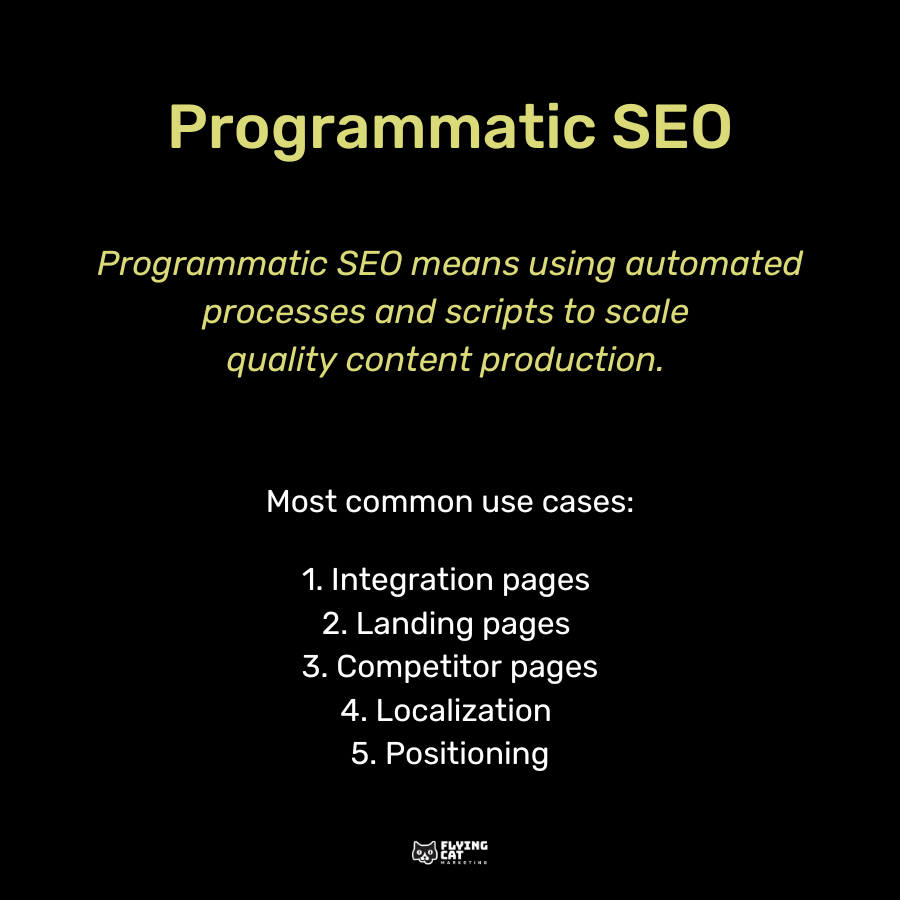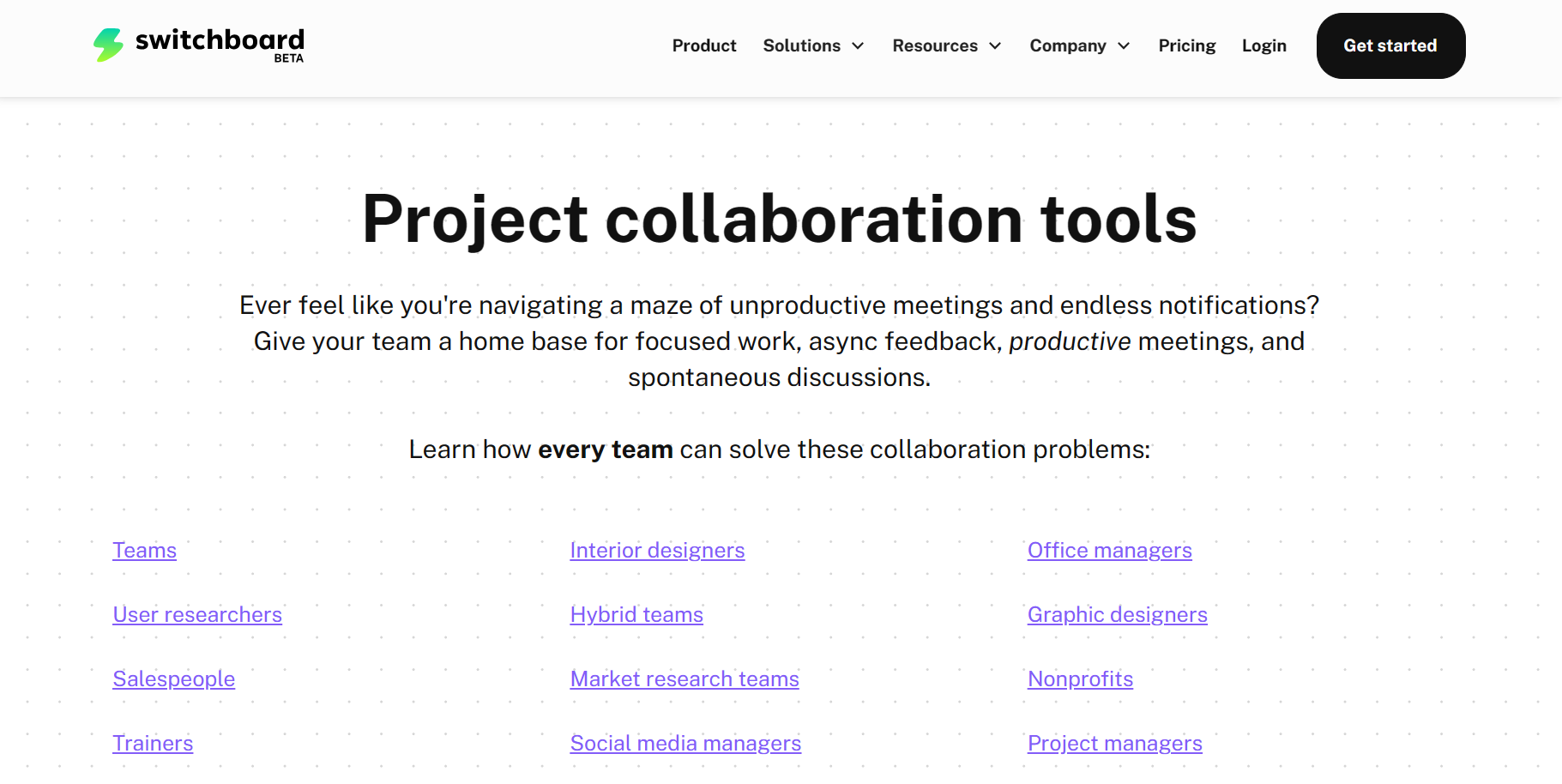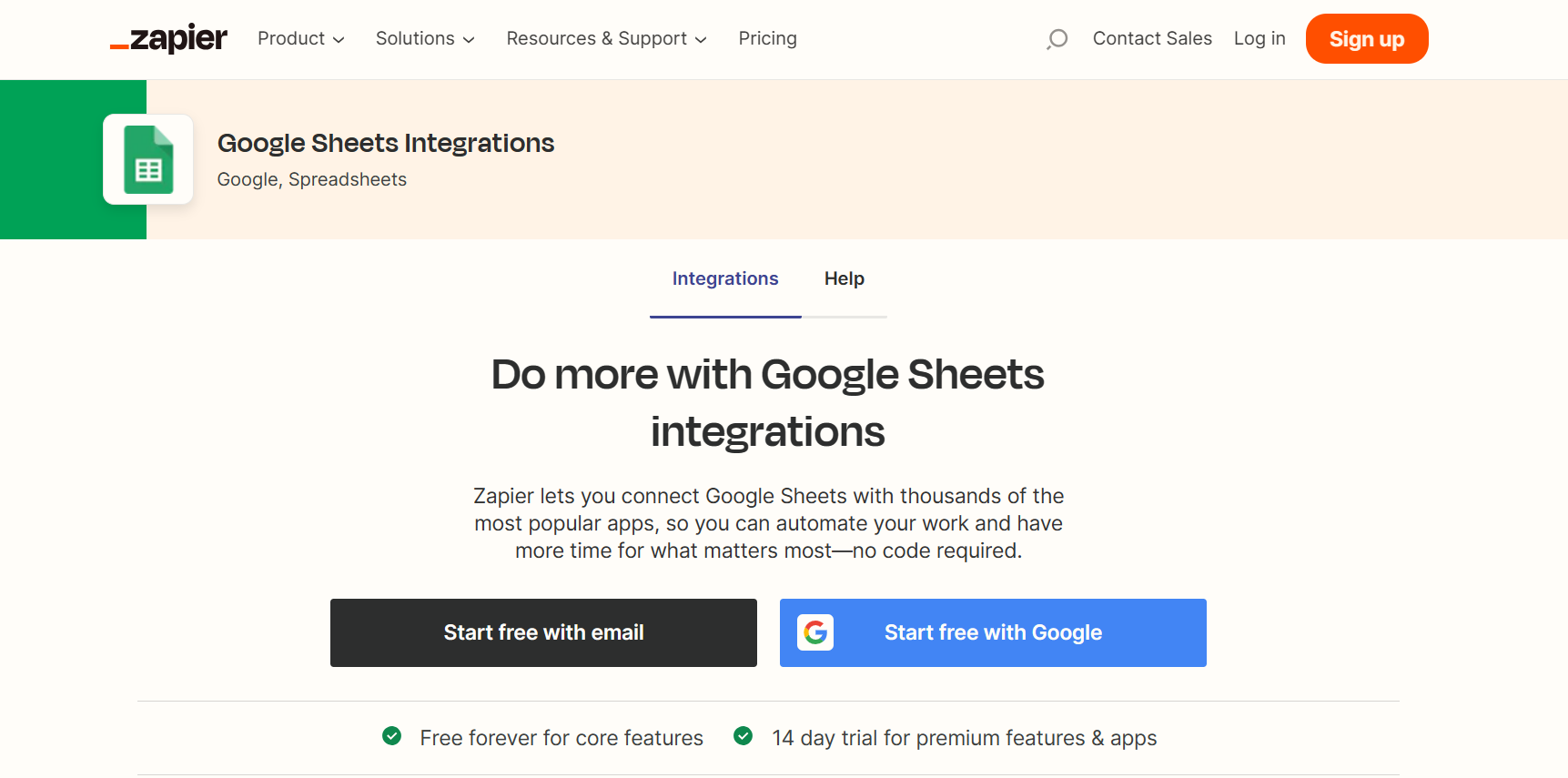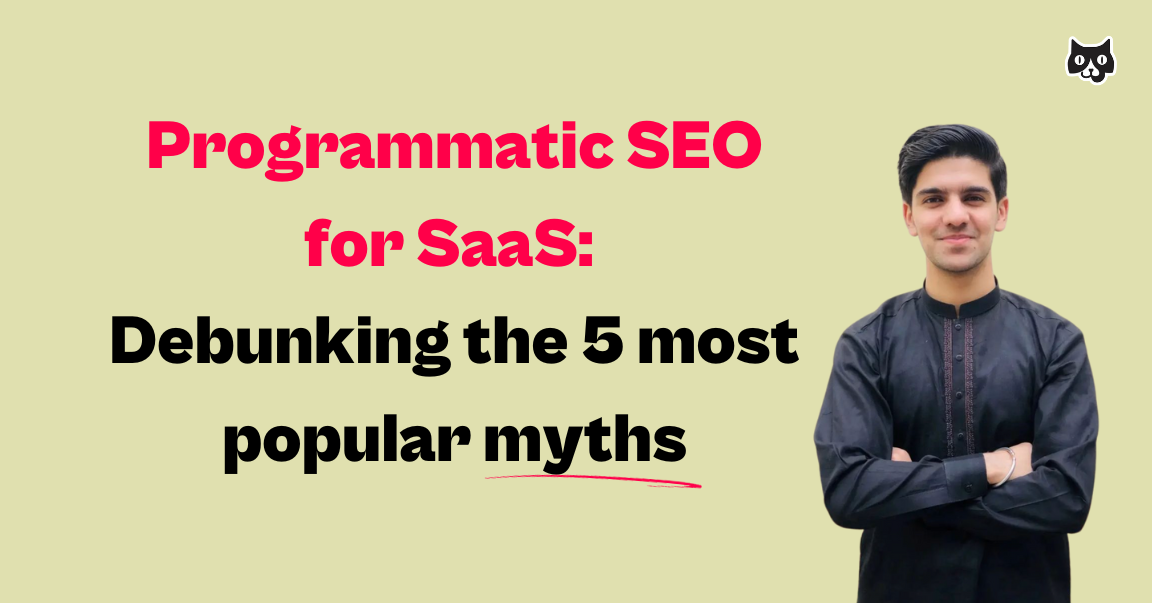Programmatic SEO (pSEO) is getting all the hype in the B2B SaaS world, but is it just another tactic to win momentary traffic? Won’t using the same kind of content across different pages get you penalized by Google? How do you prove the value of this approach to your execs if you’re worried about cannibalization?
The truth is, creating quality content at scale manually, while keeping costs down, isn’t actually feasible. pSEO gives you an alternative approach and it’s probably easier to implement than you think.
Here are five of the most popular myths about pSEO busted, along with some real-life examples of the tangible success it can bring for your company.
What is programmatic SEO?

Programmatic SEO is a marketing strategy that involves using automated processes and scripts to optimize web pages for search engines.
In this approach, you use a database of content to create a large number of pages quickly with the main objective of scaling your output while minimizing effort. In plain English, what you want to do is publish tons of content that are still relevant, of high quality, and that speak to your audience but doesn’t cost you a lot of money.
Traditionally, content writers would manually optimize elements like landing pages by carefully crafting meta tags, headings, and keyword-rich content. But with programmatic SEO, you can automate these tasks using templates and scripts.(Although, scripts aren’t completely necessary. Sometimes, you can do without them.)
What are some common use cases for pSEO?
Because of its data-driven nature and use of automations and templated content, pSEO is perfect for creating integration, landing, and competitor pages along with helping with localization and positioning.
Let’s break that down.
pSEO is a suitable approach for integration, landing, and competitor pages because they frequently require:
- Extensive data management: With this type of content, you need to give your reader a lot of information about various tools, features, benefits, and how well things work. This means you have to gather, sort, and arrange a lot of information. pSEO uses technology to do this work automatically, making it easier to collect, sort, and show the information in a way that’s easy to understand and helpful for users.
- Up to date content: In the SaaS world, things change at the speed of lightning. pSEO uses automatic monitoring and updating tools, to easily keep your pages current without you having to change things manually every few weeks.
- Consistent formatting: These types of pages are most effective when things follow the same format throughout. Because then, users can find and compare information across different sections. Programmatic SEO uses frameworks and placeholders for elements like meta tags, headings, and other variables that can be automatically populated based on predefined rules or data inputs.

Programmatic SEO is especially suitable for creating landing pages to target different customer segments.
Let’s say you’re creating some landing pages for “project collaboration tools for [X].” Within this long-tail keyword, X, is a placeholder that can change based on the niche you’re targeting. With pSEO, you could pretty easily create landing pages that follow similar formatting like:
- “project collaboration tools for [teachers]”
- “project collaboration tools for [freelancers]”
- “project collaboration tools for [startups]”
- “project collaboration tools for [small businesses]”
By using these dynamic modifiers and templated content, you can systematically optimize the landing pages to perfectly align with the exact user intent of your target audience.
Now let’s see how pSEO helps with localization and positioning.
Programmatic SEO for localization
Localization is when you make your content very specific to a geographic area so it resonates with that particular audience.
For example: maybe you’re a service that can be bought regardless of the geography, let’s say a software development company, you don’t mind working with European or American folks. But they might mind about that, and might be looking for a service in their area.
In this case, their searches will be more localized, “like ‘software development shops in London’ or ‘software development shops in Berlin.’ In this case, it makes sense to create those pages and capture those leads. “You can do this with all sorts of different regions, cities, and districts.”
Programmatic SEO for positioning
You can also use pSEO to help you nail down your positioning, especially if you have an early-stage product. “If you’re trying to figure out who your ideal customer profile (ICP) is and which niche you should go for” pSEO is a cost-effective and fast way to do that.
For example, let’s say you have a 3D product configurator tool and you’re not sure if this tool is better for e-commerce customers or for construction services. pSEO helps you get your product in front of people and explore that to see which way gets more traction.
“Sometimes, you might not have the marketing budget to check out every single possibility and see which one sticks when you need revenue now,” Varya says. With pSEO, you can experiment in a more low-stakes scenario and get to know your place within the market better.
Sounds too good to be true? Not if you tackle it correctly.
Debunking myths: Does programmatic SEO work for B2B SaaS?
Let’s take a look at some common pSEO myths and how the right programmatic SEO strategy can debunk them.
Myth 1: Cannibalization
Fact: If all the pages you’ve created are serving a unique search intent from a user-experience standpoint, solving a unique problem, providing unique value on each page, then you don’t have to worry about your content overlapping.
That’s because there’s no such thing as keyword cannibalization. There’s only search intent cannibalization.”
Let’s use the head term “online meeting tools” as an example. By changing certain variables, like who you’re targeting, and phrases in your copy, your page instantly becomes relevant for the totally different user persona. “Online meeting tools for small businesses” answers a different need than “online meeting tools for teachers.”
That’s because teachers and small businesses have completely distinct priorities and requirements:
- Teachers need online meeting tools for educational purposes. They might prioritize features like screen sharing for lessons, virtual classrooms, and student engagement tools.
- Small businesses, on the other hand, need a tool to help facilitate team collaboration, client meetings, and project updates. Their focus might be on integrations with project management software and ease of use.
If you’ve identified replicable patterns in your content, you can create page templates, write unique pieces of copy, and combine them using variables to meet completely different search intents.
When that’s the case, who cares if you repeat a heading or if you have a few words overlapping? The search engine won’t care about it. If you can make sure each page provides unique value, you don’t have to worry about cannibalization.
Myth 2: You need to know how to code
Fact: Programmatic SEO isn’t dependent on coding knowledge. With the right no-code tools and platforms, you can scale your content programmatically without ever knowing how to code.
Of course, if you do have some knowledge in that area, it can only supercharge your efforts. But it’s definitely not a requirement.
If we were to create some page programmatically, we would just rely on a couple of tools like Google Sheets and some plugins to connect your database to your content management system (CMS.)
For example, you could use:
- Ahrefs for keyword research
- Google Sheets or Airtable as a database
- Semrush’s Writing Assistant tool for on-page SEO
- Google Search Console for technical SEO
- Google Analytics for data on your website’s traffic, user behavior, and conversion rates
- Zapier for creating automations and connecting your different apps
- WordPress as your CMS
Myth 3: Google can penalize you
Fact: As long as your programmatic SEO pages comply with Google’s Search Essentials, then there’s nothing to worry about.
Google penalizes websites when they use shady tactics to manipulate their rankings, like stuffing keywords unnaturally or using hidden text. Programmatic SEO, on the other hand, focuses on using data and automation to improve your website’s performance in a legitimate and user-friendly way.
When done right, programmatic SEO doesn’t go against Google’s guidelines. It actually aligns with what Google actually wants: relevant and valuable content that serves users. Automation tools help you optimize elements like meta tags and headings, but they don’t create spammy content.
What’s important is that you’re not trying to deceive or trick search engines. Instead, programmatic SEO aims to make your website more helpful and informative.
The key best practices include:
- Creating helpful, reliable, people-first content
- Using words that people would use to look for your content
- Making your links crawlable
- Telling people about your site
- Following specific best practices for images, videos, and structured data
As long as you’re creating genuine, valuable content that addresses user needs, and following Google’s best practices, you’re on the right track.
When done right, programmatic SEO doesn’t go against Google’s guidelines. It actually aligns with what Google actually wants: relevant and valuable content that serves users.
Myth 4: You can’t have quality content
Fact: Programmatic SEO doesn’t inherently lead to thin content of low quality. pSEO techniques are designed to make your content creation process more efficient and effective, but they don’t compromise content quality.
People often say ‘We can have the same content across different pages, so it doesn’t really matter, I can create just about anything”. They believe that one piece of standardized content can’t resonate with the different audiences they have. That’s simply a myth.
According to him, if you create a high-quality piece of content, and make sure the customized segments are also strong, then you can maintain the overall quality of your generated pages throughout.
Sure, automation tools and templates help you optimize certain elements of your content, like meta tags and headings. But pSEO doesn’t mean sacrificing creativity or unique content. Templates are simply tools that help streamline optimization processes. Content writers still have full control over the actual content they create within these frameworks.
Myth 5: It’s just for traffic but it doesn’t translate into actual revenue
Fact: pSEO isn’t just about creating and optimizing thousands of pages based on keywords and data. It’s also about providing relevant, valuable, and engaging content that meets the needs and expectations of your target audience.
When people search online, they’re usually looking for something specific. If your website shows up at the top of search results, it means you’re being seen by potential customers who are actively interested in what you offer. Programmatic SEO helps you capture more of these valuable leads by making it easier to rank highly on the search engine results pages (SERPs), more often.
Finally, programmatic SEO makes it easier to rank for long-tail and niche keywords and search queries, which often have higher conversion rates and lower competition than more generic ones. When it’s done strategically and effectively, you’re not just increasing traffic numbers, but also translating that into revenue.
Well-executed Programmatic SEO examples for B2B SaaS
So, we’ve told you pSEO can work. Now, how about we show you?
1. Our client, a middleware SaaS tool
Our client’s software integrates tools, like property management software, to smart locks. It helps property managers and short-term rental hosts streamline their operations, freeing up their time to focus on their guests.
We’d been producing eight pieces per month manually for the last two years. But at some point, we started feeling like we’ve exhausted a lot of the typical bottom of the funnel (BOFU) opportunities. We also knew that with a little bit of pivoting, we could get more out of their website, particularly the integration pages.
These pages were extremely high-intent. With some qualitative research, we’d seen that a lot of their users wanted to learn more about our client’s integration possibilities. So we wanted to tap into that potential. But we couldn’t possibly produce a large number of integration pages manually, because it would’ve taken us 17 years–literally.
Instead, we relied on programmatic SEO. There were three types of pages we wanted to create:
- Partner pages showing each partner integration
- Partner integration pages illustrating the benefits of connecting the two
- “How-to” pages for every partner, e.g: “How to send a smart lock code with [partner 1]”
Once we made these categories, we realized we could create 1700 pages. With pSEO, we helped them do just that in only four months. We targeted keyword combinations that had almost zero search volume, but were incredibly specific, high-intent, but low competition.
The results?
- A 35% increase in site-wide conversions
- An average of 5% conversion rate on integration pages (compared to the usual 1% of any other page on their website)
- A 72% increase in demo requests in just four months
And for the cherry on top? Our pSEO generated integration pages made up 40% of all SEO-driven demo requests and 20% of demo requests from across all the client’s marketing channels.
|
Want more details? You can read the full case study here: How Programmatic SEO Increased Conversion Rates By 35% |
2. Zapier

Zapier uses programmatic SEO to capture thousands of leads and drive ARR.
Zapier is one of the most iconic players when it comes to pSEO. Due to the nature of their tool, they’re particularly well-positioned to implement and see great results from this approach.
Since Zapier connects with hundreds of tools like Slack, Asana, and Google Sheets, it could create thousands of pages for each individual app and their combinations to show their potential customers how those integrations would work.
Let’s take Google Sheets as an example. They could create a single app page for that, and then one page per connection including:
- Google Sheets + Notion
- Google Sheets + Slack
- Google Sheets + Gmail
- Google Sheets + HubSpot
- Google Sheets + Facebook
And so on. Since the users who search for Google Sheets + [app] integrations have done the research, realized they have a specific need, and are looking for a solution, they’re more likely to go to Zapier’s pages and convert.
In fact, with the approximately 70,000 pSEO pages that Zapier created, they drove over $140M ARR.
What our team recommends to people eager to try pSEO
Start by understanding whether there’s a pSEO need for your industry or not
It’s easy to think ‘I need to do pSEO because everyone else is doing it. But first, you need to think about whether your product qualifies for such a campaign or not.
There are companies for which SEO isn’t a viable channel. This, by default, means pSEO isn’t the right campaign to invest in. Instead, think of your customers and say, ‘what are the problems that I can address in my content? Do I see a repeatable pattern in any of those problems?’
Look at Zapier. They understood their customer’s needs, identified a pattern, and started producing content at scale to meet their users where they were. That’s why starting with your customer needs is so important.
Some SEOs go straight to using keyword research tools and finding patterns within keywords, but the first thing is to start with your customer needs. Otherwise, you might end up with thousands of pages that aren’t converting very well for you.
Get buy-in from your team but manage their expectations
A common misconception that our clients have is that if they publish 20 pages, all 20 pages will bring a lot of traffic.
But with publishing at scale, some pages won’t bring as much traffic whereas others will bring you more traffic. However, seeing what works and what doesn’t makes it worth publishing all of them.
One of our clients, for example, is getting traffic and gaining revenue from keywords they weren’t even working on. This is where programmatic SEO can help you discover things you would never have been able to discover unless you’re able to publish at scale. This is an opportunity to target people who want to use your product but you don’t know how they’re searching for it.
Begin with something really simple, but do try it out
Finally, get rid of this sense of FOMO that social media instills! Programmatic SEO is here to stay, but it’s important to first try out pSEO on a small scale.
Don’t get overwhelmed by social media posts of people talking about publishing thousands of pages really quickly. Try it with five pages and see how it goes. If you can do that, then add to the complexity, try something harder, and when you continue that pattern, in 6 months to a year you’ll be in a much better place. For now, just start.
Frequently asked questions about programmatic SEO
1. What is programmatic SEO?
In content marketing, programmatic SEO (pSEO) is a way to produce unique content at scale in a short period of time by using a database, pre-defined templates, and automations. Through pSEO, you can publish a wide range of pages that are of high quality and meet the user intent, while still keeping the costs down.
2. How to start with programmatic SEO?
To get started with programmatic SEO:
- Understand the needs of your customers. Talk to your existing users and research your ICP to find out more about their problems and how you can solve them.
- Conduct research. Use keyword research tools, like Ahrefs or similar, and heat mapping tools, like Hotjar, to understand if there’s an interest in the pages you want to create.
- Build content templates. Create a page template around your head term that will contain all the modifiers of the tools you want to compare and contrast.
- Link it to a database. In a Google Sheet or Airtable base, create a database with all the variables and the copy you want to go into each template.
- Upload and connect your database to your CMS.
If you still need support, contact an SEO agency with expert strategists and skilled content writers, like FCM! It’s easy to get started, just book a call.
3. Can programmatic SEO lead to cannibalization?
No, there’s no need to worry about cannibalization with pSEO if each page targets a specific search intent and is relevant to a different target audience. There’s no such thing as content cannibalization, just search intent cannibalization.
4. Do I need to know how to code for programmatic SEO?
No, you don’t need to know how to code to take on a programmatic SEO project. You can very easily use no-code tools for keyword research, qualitative analysis, database creation, and content publication. If you are familiar with coding, your knowledge can only enhance the things you can accomplish. But it’s not a requirement.
5. Does Google penalize programmatic SEO pages?
As long as your pSEO pages and content don’t go against Google’s guidelines, there’s nothing to worry about. This means creating helpful content that’s user centric, making your links crawlable, and following Google’s best practices for images, videos, and structured data for example.
6. Can you have quality content on pSEO pages?
Yes, the quality of your content is entirely independent from the pSEO approach. pSEO streamlines the content creation process so you and your writers can dedicate more time to creating high-quality content that’s relevant to your reader.
7. Does pSEO translate to real revenue?
Yes, programmatic SEO can lead to tangible revenue growth. By optimizing content at scale, targeting specific audiences, and leveraging data-driven insights, programmatic SEO enhances search visibility and your user experience. This increases the likelihood of attracting qualified leads and converting them into paying customers.
